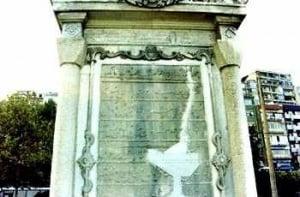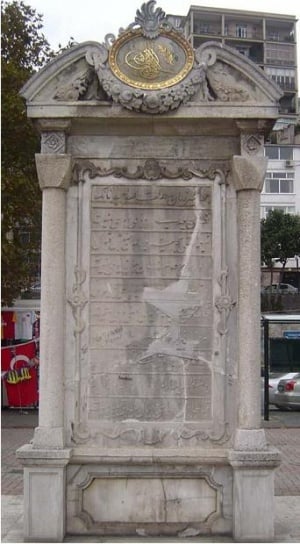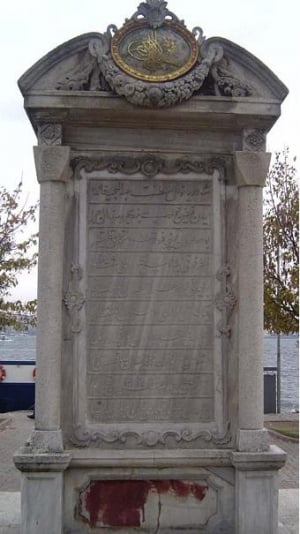Guru Nanak in Turkey
Guru Nanak (1469-1539) promulgated a uniqueand universal philosophy of humanism in the Indian sub continentwhen renaissance wastaking place on European continent (14 th to 16th centuries) and scientists were challenging illogical religious concepts and beliefs.Guru Nanak Carried his message far and wide in South Asia and Middle East. He held discussions with religious leaders- Hindus (Brahmans,Sidhs andJogis), Muslims(Sufis,mullahsandQazis),Jains and Buddhistsin India, Middle East, Tibetand Ceylon.During his travels(odysseys,Udasis) Guru Nanak challenged the ancient mythology, wrong religious concepts and ritual swith which the peoples of South Asia and Middle East were shackled for centuries.People were unable to express their freewill in any aspect of their lives because their lives were controlled by their religious and political authorities. Guru Nanak launched his movement to liberate the masses form ignorance and religious and political tyranny. His philosophy, termed as ”Nanakian Philosophy‘,isembodied in his Bani(Word),which has been incorporated in the Aad Guru Granth Sahib (AGGS).Nanakian Philosophy was further explained and strengthened by the Sikh Gurus who succeeded to the ”House of Nanak‘in their Bani,which is also incorporated in the AGGS.A critical study of Nanakian Philosophy demonstrates all characteristics of universal acceptability and compatibility with the current Age of Science. Although there are many gapsin the travels of Guru Nanak,Fauja Singh and Kirpal Singh,Sikhhistorians, have collated the information from various sources into three major travels as follows:
- From Talwandi to Sultanpur to Benaras to Dhubri to Assam to Dacca to Ceylon to Ujain to Mathura to Talwandi.
- From Talwandi to Kailash (Sumer) Parbat to Talwandi.
- From Talwandi to Hinglaj to Mecca to Baghdad to Kabul to(Talwandi) Kartarpur.
Besides the above travels there are many short ones in Punjab and adjoining areas.Fauja Singh and Kirpal Singh have also mentioned that according to ”Janam Sakhis‘ (biographies of Guru Nanak) by Meharban and Bhai Mani Singh Guru Nanak had also travelled to Palestine, Syria and Turkey,although there is no definite supporting evidence.Some writers of Janam Sakhis have extended his travels even to some countries in CentralAsia. Nonetheless,it is evident from the information collected by Fauja Singh and Kirpal Singh that the complete travels of Guru Nanak are still to be discovered. Moreover,research on the discourses held between Guru Nanak and the heads of various religious centers also need to be described, although some discourses,e.g.Sidh Gosht,Arti,and Onkar Bani are found in the AGGS and some isolated verses of Guru Nanak arelinked to some travels in some Janam Sakhis.
NEW DISCOVERY
I was attending an International Conferenceon Bioenergy in Istanbul,Turkey in 1994 where I also presented my research work on the ”Production of Ethanolas a Source of Energy from Wood‘.On the last day of the conference all the participants went on acruise in the Straits of Bosporus (Bosphorus), connecting the Black Sea and the Sea of Marmora(about32 km) long. The Straits of Bosporus is an important place where East Ends(Main land of Turkey in Asian Continent) and the West Starts (Istanbulin European Continent). On my return from the cruise,when I was walking towards the bus waiting for us,I discovered a big monument.This monument is about 15 ft high and about 6ft wide constructed in mortar.It is situated in a public park atthe shore ofthe Straits of Bosporus towards Istanbul,Turkey.It has some inscription in Arabic/Persian Alphabet. When I looked at the inscription on this monument I found very clearly ”Nanak‘inscribed attheend of the first line of its inscription.The bulk of inscription is not legible because of the effect of weathering agencies and there are some small and big cracks which were filled with cement.Moreover,it is in old Turkish language in Arabic alphabet that is difficult to read.However,I was able to read —Nanak“ for sure since I know Arabic alphabet and I decided to take a picture of the monument with its inscription for further investigation later.Next morning I came back home to Canada. On my return I consulted a student of mine from Turkey to decipher the inscription.She showed her inability to decipher because it was not legible.Then I tried a couple of more persons from Turkey without any success.Further research to decipher its inscription remained dormantfor 12 year still I visited Lahore, Pakistan to participate in an International Conference on Guru Nanak Heritage for Peaceon February 18,2006
THEINSCRIPTION
I found the importance of the monument only when Mr. Iqbal Kaiser, the author of a book, ”Sikh Shrines in Pakistan‘, and Mr. Syed Afzal Haider,Senior Advocate of Supreme Court of Pakistan, and the author of a book, ”Baba Nanak‘, helped me to decipher the first line of the inscription, which is in Turkish language.It clearly indicated that it is dedicated to Guru Nanak. The first line deciphered by them is as follows:
In Turkish language (Transliteratedin Gurmukhi Script):
jhWgIr jmW ihMd lq Abd Al mwjId nwnk [ (Jehangirjamanhind latabd almajid Nanak.)
Meanings in Punjabi:
jmwnydw mwlk,ihMd dw bMdw,rb dw nwnk [
(jamanaydamalik,hind dabanda,rabdaNanak)
Meanings in English:
The Lord of the time,resident of India,Nanak the man of God.
The rest of the long inscription is notlegible and is still to be deciphered/
THETRAVELS
The above new discovery of a monument of Guru Nanak may connect the travel of Guru Nanak from Mecca to Israel, Palestine, Syria, and Turkey and then to Baghdad rather than directly to Baghdad from Mecca asis generally accepted.The general accepted travel of Guru Nanak, entirely based on the information given by Fauja Singh and KirpalSingh, is drawn in solid lines in According to them Guru Nanak started his travel from Talwandi to Sultanpur to meet his sister before proceeding to a long travel.From Sultanpur he went to Pakpattan (Ajodhan) to renew his old contacts with Sheikh Ibrahim Farid II.From there he proceeded to Multan to meet Baha-ud-Din, a descendant and successor of famous Sheikh Baha-ud-Din Zakria, founder of Suhrawardhy Sufi Silslah in India. From Multan Guru Nanak proceeded to Uch (Deogarh).Here Guru Nanak hada meeting with Sheikh Haji Abdulla Bukhari(d.1526 CE),a successor of Kalal-ud-Din Bhukhari. From Uch to Sukkur to Lakhpat (Basta Bander) probably by boat(in river Sind?).There is an old Gurdwara in the memory of Guru Nanak‘s visit.From here he proceeded to the sea shore where at Kurianihe visited old temples of Koteshwar and Narayna Swami. From there he proceeded further to Sonmiani(or simply Miani). Before boarding a boat to Mecca he visiteda Hindu templein Hinglaj. There is a Nanak Dharamsala (inn) in this town.
According to Fauja Singh and KirpalSingh Guru Nanak boarded a boat which sailed from Sonmiani through Gulf of Eden and Red Sea to Jeddah (Al Aswad),a port near Mecca. They say that after visiting Mecca and Medina Guru Nanak traveled directly to Baghdad in Iraq then to Tehran and Kabul and finally back to (Talwandi) Kartarpur. The yargued that Guru Nanak followed direct and shortest route to Baghdad than that of long route through Palestine, Syria, and Turkey as mentioned in some Janam Sakhis. However,Dr Trilochan Singh has reported that there are some indications that Guru Nanak visited Cairo(Egypt) where during the war Sikh soldiers were shown a place on the out skirts of the town where there was a stone memorial(Captain Bhag Singh,Founding Managing Editor of the Sikh Review, was told about the existence of this monument when he was at Cairo during World War II. Unfortunately he could not go there and see.Dr Trilochan Singh has also reported from the work of Sydney Nettleton Fisher that in Egypt or in Istanbul(Turkey) Guru Nanak had met the Emperor of Rum Salim (1511-1520CA).Dr Trilochan Singh further says thatGuru Nanak might have visited Jerusalem. Because of a lack of any solid evidence, Fauja Singh and Kirpal Singh further strengthened their views that the shortest route from Baghdad to Mecca was first marked and prepared for Khalifa Harun Rashid‘s wife, Zubaida Begum, for Hajj(the pilgrimage) to Mecca. And then during 14th century Ibn Batula adopted the same route for his journey from Baghdad to Mecca. They have ignored the fact that the passage to Palestine, Syria, and Turkey and then to Baghdad might be easier than that of direct route proposed by them. They have also ignored another fact that while in Mecca Guru Nanak was very close to thecenter of ancient civilization in Cairo (Egypt) and center of Jews, Jerusalem (Israel), and a Sufi center established by Hazrat Moulana Jallaluddin Rumi in Konya (Turkey),whose philosophy was very prevalent not only in the Middle East but also in India and now in the West. Since Guru Nanak has not left any place connected with Sufism, and religious centers, therefore, there is every possibility that Guru Nanak might have visited the ancient civilization in Cairo(Egypt), Wailing Wall of Herod”s Temple in Jerusalem, Sufi center started by Sufi Rumiin Konya(Turkey) and might have met the Emperor of Rum, Salim, in Istanbul(Turkey). If the inscription on the newly discovered monument confirms that it is a memorial to Guru Nanak then it will confirm that Guru Nanak did notproceed from Mecca directly to Baghdad but went to Cairo, Jerusalem, Syria, and Konya and Istanbul in Turkey and then to Baghdad
OBJECTIVE
Dr Trilochan Singh [3]hasreported thatQazisand Hajjisaddressed Guru Nanak as”Nanak Hindvi‘or ”NanakHindki‘.Thefirstlineoftheinscription clearly indicatesthatitisrelatedtoGuru Nanak whohasbeen addressed as —hind da banda, rab da Nanak.“ Therefore,itbecomesimperativefor scholarsandthe Sikhsatlargetodecipher restoftheinscription tofind out: Isthisinscription aboutGuru Nanak‘svisittoTurkey? Iftheinscription isaboutGuru Nanak then whatisthe completemessage? Isita memorialconstructedin commemoration ofGuru Nanak?Andsoon. TheInstituteforUnderstandingSikhism hastaken up this research project to study the history of this discoveredmonumentdedicatedtoGuru Nanak on the followinglines: ñ To relocate the site ofthe monumentand the importance of thatsite to the tourists visiting Istanbul. ñ To discover the original inscription of that monumentand deciphering itinto English and Punjabi. ñ Todiscover anyinformation relatedtothevisitof Guru Nanak in Turkey. ñ To visit various shrines of Hazrat Moulana Jallaluddin Rumito discover the possibilitiesof discourseofGuru Nanak with thethen religious leadersofthoseshrineofthattime. ñ Tosearchfor evidenceofmeetingofGuru Nanak withEmperor ofRum,Salim,in Istanbul. ñ To discuss the matter with the Archeology DepartmentandtheMunicipalityofIstanbulaboutthe future maintenance of this monumentand to discussthepossibilitiesto erectsimilar monuments withEnglishandPunjabitranslationsoftheoriginal inscription ofTurkish. ñ Todeliver a talk on ”TravelsofGuruNanak in India andMiddleEast‘tothefacultyandstudentsofthe DepartmentofArcheology,UniversityofAnkara. ñ Todiscover thereturn routefollowedbyGuru Nanak after visitingMecca andMedina in SaudiArabia. ñ Finally to publish a Reportaboutthe findings of researchconductedandthen writinga book,Travels ofGuruNanak,withspecialreferencetodiscoveryof thismonument
APPROACH Iam already in contactwith Mr.TugrulBiltekin,First Secretary in the Embassy of Republic of Turkey in Ottawa,Canada.He is ready to help me to conduct research on this projectand allow me to consultthe concerneddocumentsin theDepartmentofArcheologyin Ankara and its branch in Istanbul and also the municipality of Istanbul. Meeting with the religious leadersofshrinesofSufiRumiin Konya,Turkeywillalso bearrangedbyhim todiscover thepossibilityofvisiting thisshrinebyGuru NanakACHIEVEMENTS ñ Deciphering ofthewholeinscription on this new discovered monumentwillconfirm the visitofGuru Nanak toTurkey. ñ The confirmation of connection of this monument with Guru Nanak will further strengthen thepossibilitiesofvisitsofGuru Nanak to Cairo (Egypt),Jerusalem (Israel), Syria, Lebanon, and Turkey (dotted lines) coveringthewholeMiddleEastsincevisitto Mecca,Baghdad,Tehran,and Kabul(solid lines) hasalreadybeen confirmed(Fig.4). ñ Thelocation oftheMonumenton a publicpark on theshoreoftheStraitsofBosporustowards Istanbul, Turkey on European Continent enhancesitsimportancefor thetouristsofthe world(Fig.1). ñ Theaboveachievements,on completion ofthis researchprojectaregoingtoprovethetravelof Guru Nanak to the end of Middle East (Turkey) and beginning of the Europe (Istanbul) and establishmentofa new shrine (A place or structure esteemed for its importanceor centralityin Sikhhistoryandas a memorialto Guru Nanak) - - A pridefor everySikh
FUTUREPLAN Theoriginalmonumentistobepreservedassuchwith itsdamagedinscription.A similar monumentistobe constructedwiththeoriginalinscription,whichwould beclearlylegible.Stillanother suchmonumentistobe constructed on which the translation ofthe original inscription in Punjabitobeinscribedon onesideand Englishtranslation on theother side.Thiswillbecome an historicalpilgrimagefor theSikhsin Istanbulon the shoreofStraitsofBosporuson European Continent wheretheEastmeetstheW est. TheroleofUNESCO in maintainingthismonumentas WorldHeritagewillbeexploredafter decipheringthe inscription on thenewlydiscoveredmonumentofGuru Nanak. FUNDING Theestimated funding required to completethefirst phaseofthisresearch projectisabout$50,000.The devoutSikhsandtheGurdwarasarerequestedtomail their checks (in the name of ”Institute for Understanding Sikhism‘) to the Institute for Understanding Sikhism, 4418 Rue Martin-Plouffe, Laval,Quebec,Canada H7W 5L9. TheInstitutefor Understanding Sikhism is charitable organization federally incorporated in Canada. Receipts for donationsareissuedfor IncomeTaxdeductions.
ACKNOWLEDGMENTS Theauthor isgratefulto DrsAvtar Singh Dhaliwal, SarjeetSinghSidhu,BalbirSingh,BaldevSingh,Teja Singh,Kulbir Singh Thind and Dr (Mrs) Khushdev Thind for their helpfulsuggestions to improve its presentation. My special thanks are due to Dr Parminder SinghChahal,myson,for preparingFigures 1and4.ThebasicFigure1of”StraitsofBosporus‘ separatingEastandWestisfrom NASA taken from the space,mythanksareduetoNASA for thispicture.
Update(5th Jan 2007)
Since the ‘Discovery of Monument of Guru Nanak in Istanbul’ was announced and published in various magazines and newspapers in India and Canada, it has created a great curiosity among the Sikhs all over the world. Now every Sikh want to see this monument. In continuation of our further research, we are proud to inform that the Monument has been relocated in collaboration with Mr. T. Sibia of London, UK and Mr Jatinderpaul Singh of Ramtex Exports. Ludhiana. We are glad that the monument is still in very good conditions after 12 years when it was discovered in 1994. To my surprise the relocation has indicated that there is also some inscription on the back of this monument. The full size pictures of the monument with front side and back sides are shown as follows. Calligraphic writing at the top with gold is BISM ALLAH (Starting in the Name of Allah).
CONTINUATION OF RESEARCH
Our research for deciphering the inscription and to find out the background history of this monument is going on. Here is an update on the discovery of monument of Guru Nanak:
UPDATING
Our initial research after consulting a number scholars indicates that there is need of hard and serious efforts to work with scholars not only experts in Arabic and Per-sian but also in Turkish, and who are familiar with the status of these languages of that time. Whatsoever, we have discovered through the help of scholars from Mont-real and from Istanbul in coordination with Mr. T. Sibia is as follows:
First Deciphering Attempt
I found the importance of the monument only when Mr. Iqbal Kaiser, the author of a book, ‘Sikh Shrines in Paki-stan’, and Mr. Syed Afzal Haider, Senior Advocate of Supreme Court of Pakistan, and the author of a book, ‘Baba Nanak’, helped me to decipher the first line of the inscription, which is in Arabic/Persian/Turkish language (Fig. 1. Front view). It clearly indicates that it is dedi- cated to Guru Nanak. The first line deciphered by them is as follows:
In Arabic/Persian/Turkish languages (Transliterated in Gurmukhi Script):
jhWgIr jmW ihMd lq Abd Al mwjId nwnk [
(Jehangir jaman hind lat abd al majid Nanak.)
Meanings in Punjabi:
jmwny dw mwlk, ihMd dw bMdw, r~b dw nwnk [
(jamanay da malik, hind da banda, rab da Nanak)
Meanings in English:
The Lord of the time, resident of India, Nanak – the man of God.
The rest of the long inscription is not legible and is still to be deciphered. However, the date, 1267 Hijri (1850 CE), in the crown and at the bottom line of the monu-ment is quite legible
When we examined the inscription on the other side of the monument (Fig. 2. Back side) it appears that inscrip-tion was engraved either in 1217 or 1267 Hijri, which is equivalent to 1802 or 1850 CE. The later date (1850 CE) appears to be correct since the Emperor of Ottoman Empire (1839-61 CE) was Abd-al-Majid (1823-61 CE). It is also assumed that the name of the inscriber is also Abd-al-Majid, which appears above that date. Abd-al-Majid is very common name among Muslims. And ‘Abd-al-Majid’ is also written before ‘Nanak’ at the end of the first line on the front side of the monument. Then ‘Abd-al-Majid’ is also appearing at the end of the first line on the back side of the monument. Now the question is:
Who is ‘Abd-al-Majid Nanak’?
Although the word ‘Nanak’ was not found in common Arabic and Persian Dictionaries, however, it cannot be ignored that ‘Nanak’ is the family or last name of some persons. On the other hand we have also noticed that ‘Hazrat Rab Majid Baba Nanak Faqir’ is found in an inscription on a stone in Baghdad dated 917 Hijri which is equivalent to 1511 CE. This further forces us to look into these inscriptions seriously and also along with other related writings to find the truth that:
Who is this ‘Nanak’ in the inscription on monument discovered in Istanbul?
Further study on its history indicates that this monument was built in the name of Ottoman Empire Sultan Abd-al-Majid in 1267 Hijri (1850 CE). A port was established in that area (Kabata) in order to save the boats of Sultan from heavy winds and this stone monument was put there at that time. On back side of the monument the benefits of the port are written and on front side facing the Straits of Bosporus there is prayer for the Sultan. If it is so then: Is this prayer connected to Guru Nanak?
The place of the monument was changed from it's origi-nal place when there was road construction and on 1987-1988 it was restored by government, now it is located in the same area which is called Kabata (near dolmabahçe palace)
At present it looks like that until the whole inscription on both sides of the monument is deciphered it is difficult to draw any inference to relate it to Guru Nanak.
Since the date (1850) on the monument indicates that it was constructed more than 300 years after Guru Nanak (1469-1539 CE), it creates another curiosity that how come somebody will raise a monument with inscription containing the name of Guru Nanak after that long time?
It also needs a serious research to look into the history of Sufism in Middle East and their interaction with the Suf-ism in India since in the Muslim world Nanak is known a Sufi named as ‘Baba Nanak’, Baba Nanak Fakir, and even as ‘Hazrat Rab Majid Baba Nanak Faqir’ on the stone at Baghdad.
Besides a new line of research, “To study the interaction of the philosophy of Guru Nanak from an angle of his Sufism with that of Middle East Sufism” has also become an important research project for the IUS.
REFERENCES
- Fisher,SydenyNettleton.Year?TheMiddleEast: A History.p20639.J.M.S.(LI)281.
- Singh,Fauja,and Singh,Kirpal.1976.Atlas:Travels of Guru Nanak. Punjabi University, Patiala.
- Singh,Trilochan.1969.Guru Nanak:Founder of Sikhism.Gurdwara Parbandhak Committee,Sis Ganj,ChandiniChowk,Delhi.



